Chemistry > GCSE MARK SCHEME > GCE Chemistry A H432/01: Periodic table, elements and physical chemistry Advanced GCE Mark Scheme fo (All)
GCE Chemistry A H432/01: Periodic table, elements and physical chemistry Advanced GCE Mark Scheme for Autumn 2021
Document Content and Description Below
GCE Chemistry A H432/01: Periodic table, elements and physical chemistry Advanced GCE Mark Scheme for Autumn 2021 Oxford Cambridge and RSA Examinations GCE Chemistry A H432/01: Periodic table, e... lements and physical chemistry Advanced GCE Mark Scheme for Autumn 2021Oxford Cambridge and RSA Examinations OCR (Oxford Cambridge and RSA) is a leading UK awarding body, providing a wide range of qualifications to meet the needs of candidates of all ages and abilities. OCR qualifications include AS/A Levels, Diplomas, GCSEs, Cambridge Nationals, Cambridge Technicals, Functional Skills, Key Skills, Entry Level qualifications, NVQs and vocational qualifications in areas such as IT, business, languages, teaching/training, administration and secretarial skills. It is also responsible for developing new specifications to meet national requirements and the needs of students and teachers. OCR is a not-for-profit organisation; any surplus made is invested back into the establishment to help towards the development of qualifications and support, which keep pace with the changing needs of today’s society. This mark scheme is published as an aid to teachers and students, to indicate the requirements of the examination. It shows the basis on which marks were awarded by examiners. It does not indicate the details of the discussions which took place at an examiners’ meeting before marking commenced. All examiners are instructed that alternative correct answers and unexpected approaches in candidates’ scripts must be given marks that fairly reflect the relevant knowledge and skills demonstrated. Mark schemes should be read in conjunction with the published question papers and the report on the examination. © OCR 2021H432/01 Mark Scheme October 2021 1 Tuesday 5 October 2021 –Afternoon A Level Chemistry A H432/01 Periodic table, elements and physical chemistry MARK SCHEME Duration: 2 hours 15 minutes MAXIMUM MARK 100 Last updated: 17/10/2021 Post-standardisation This document consists of 27 pages1. Annotations Annotation Meaning Correct response Incorrect response Omission mark Benefit of doubt given Contradiction Rounding error Error in number of significant figures Error carried forward Level 1 Level 2 Level 3 Benefit of doubt not given Noted but no credit given Ignore2. Abbreviations, annotations and conventions used in the detailed Mark Scheme (to include abbreviations and subject-specific conventions). Annotation Meaning / alternative and acceptable answers for the same marking point Separates marking points DO NOT ALLOW Answers which are not worthy of credit IGNORE Statements which are irrelevant ALLOW Answers that can be accepted ( ) Words which are not essential to gain credit __ Underlined words must be present in answer to score a mark ECF Error carried forward AW Alternative wording ORA Or reverse argumentH432/01 Mark Scheme October 2021 Question Answer Marks AO element Guidance 1 C 1 AO1.1 2 B 1 AO1.2 3 D 1 AO2.6 4 B 1 AO2.2 5 D 1 AO2.6 6 C 1 AO2.6 7 A 1 AO1.1 8 B 1 AO2.2 9 B 1 AO2.2 10 A 1 AO2.6 11 A 1 AO1.2 12 C 1 AO1.2 13 D 1 AO1.1 Accept 1 14 B 1 AO2.1 15 C 1 AO2.3 Total 15Question Answer Marks AO element Guidance 16 (a) Diagram with regular arrangement of labelled ‘Mg2+ ions’ OR ‘2+ ions’ AND attempt to show electrons Labelled electrons between other species AND statement anywhere of delocalised electrons (can be in text or in diagram) Electrons move 3 Regular arrangement must have at least two rows of correctly charged ions and a minimum of two ions per row ALLOW as label: +2 ions OR + 2 cations OR +2/2+ seen within circle ALLOW e– or ‘e’ as a label for electron IGNORE “–“ for electron label ALLOW mobile/flow for move IGNORE ‘carry charge’ (b) (i) Mg3+(g) → Mg4+(g) + e– 1 AO1.2 State symbols required (ignore states on electrons) ALLOW Mg3+(g) – e– → Mg4+(g) ALLOW Mg+3 (g) ALLOW e for e– (b) (ii) Big jump/larger difference between 2 and 3 1 AO1.2 IGNORE big jump between 10 and 11 DO NOT ALLOW other combinations. (b) (iii) 1st AND 3rd AND 4th AND 5th AND 9th AND 11th i.e. 1 2 3 4 5 6 7 8 9 10 11 12 1 AO2.1Question Answer Marks AO element Guidance (c) (i) (enthalpy change for) 1 mole of a compound/substance/solid/solute dissolving 1 AO1.1 IGNORE ‘energy released’ OR ‘energy required’ For dissolving, ALLOW forms aqueous/hydrated ions IGNORE ionic OR covalent DO NOT ALLOW dissolving elements DO NOT ALLOW response that implies formation of 1 mole of aqueous ions (c) (ii) Mg2+(aq) + 2F–(g) Mg2+(aq) + 2F–(aq) 2 AO2.2 ×2 ALLOW Mg2+(g) + 2F–(aq) ALLOW MgF2(aq) (c) (iii) –6 (kJ mol–1) ∆solH (MgF2) = – (–2926) + (2 × –506) + (–1920) 1 AO2.2 1 mark ONLY (c) (iv) Ionic radius Halide ion gets larger down the group Lattice enthalpy Lattice enthalpy is less exothermic down group OR halide ion has less attraction for Mg2+ Hydration enthalpy Hydration enthalpy is less exothermic down group OR halide ion has less attraction for H2O Enthalpy of solution Difficult to predict whether lattice enthalpy or hydration enthalpy has bigger effect 4 AO1.2 ×3 AO3.2 ALLOW ORA throughout ALLOW ions closer together in MgF2 OR further apart in MgI2 DO NOT ALLOW atomic radius ALLOW MgI2 is less exothermic than MgF2 for LE and hydration enthalpy -as trend ‘down the group’. ALLOW less negative/more positive BUT IGNORE is smaller/less Total 14Question Answer Marks AO element Guidance 17 (a) Transition element: Has an ion with an incomplete/partially-filled d subshell/d-orbital d-block d sub-shell/d-orbital is being filled/has highest energy OR Electron configurations shown for Sc: 1s22s22p63s23p63d14s2 AND Zn:1s22s22p63s23p63d104s2 Electron configurations of ions Sc3+: 1s22s22p63s23p6 AND d sub-shell empty / d orbital(s) empty Zn2+: 1s22s22p63s23p63d10 AND d sub-shell full / d-orbitals full 4 AO1.1 ×4 FULL ANNOTATIONS MUST BE USED ------------------------------------------------------ DO NOT ALLOW d shell IGNORE d block IGNORE outer electron electron configurations ALLOW 4s0 ALLOW 4s2 before 3d, i.e. …..4s23d1; 4s23d10 IGNORE other Sc and Zn ions ALLOW ECF for short hand notation. For Sc3+, ALLOW Sc+3 OR Sc forms a 3+ ion; For Zn2+, ALLOW Zn+2 OR Zn forms a 2+ ion; (b) (i) Donates two electron pairs (to a metal ion) AND forms two coordinate bonds (to a metal ion) 1 AO1.1 x1 ALLOW lone pairs for electron pairs ALLOW dative (covalent) bonds for coordinate bonds TWO is only needed once if bonds are plural, e.g. Donates 2 electron pairs to form coordinate bonds Donates electron pairs to form 2 coordinate bondsQuestion Answer Marks AO element Guidance (ii)* Please refer to the marking instructions on page 4 of this mark scheme for guidance on how to mark this question. Level 3 (5–6 marks) Reaches a comprehensive conclusion with most detail and few errors to obtain: the formulae of A and B AND ionic equation for ligand substitution AND the 3D structures of B stereoisomers There is a well-developed line of reasoning which is clear and logically structured. The information presented is relevant and substantiated. Level 2 (3–4 marks) Reaches a sound conclusion with some detail and some errors for the formula of A OR B AND ionic equation for ligand substitution OR the 3D structures of B stereoisomers There is a line of reasoning presented with some structure. The information presented is relevant and supported by some evidence. Level 1 (1–2 marks) Obtains the correct formula of A OR B OR 3D structures of B stereoisomers which are mostly correct. There is an attempt at a logical structure with a line of reasoning. The information is in the most part relevant. 0 marks No response or no response worthy of credit. 6 AO2.2 ×2 AO2.6 ×2 AO3.1 ×2 Indicative scientific points: 1. Formula of the hydrated salt A Formula of A: Cr2H24O24S3 Example of working Cr : H : O : S 17.10 52.0 : 3.94 1.0 : 63.13 16.0 : 15.83 32.1 There may be other methods Detail Hydrated salt = Cr2(SO4)3•12H2O 2. Formula of B and ionic equation Formula of B: [Cr(H2O)2(C2O4)2]– Ionic equation [Cr(H2O)6]3+ + 2C2O42– → [Cr(H2O)2(C2O4)2]– + 4H2O ALLOW ligands in any order, e.g. [Cr(C2O4)2(H2O)2]– Detail Use of charges and brackets 3. 3D structures of B stereoisomersQuestion Answer Marks AO element Guidance • Consistent use of 2 ‘out wedges’, 2 ‘in wedges’, 2 lines in plane of paper OR 4 lines, 1 ‘out wedge’ and 1 ‘in wedge’ ALLOW following orientations Detail • Most bonding shown from Cr to O of H2O and O– C2O42– Total 11Question Answer Marks AO element Guidance 18 (a) Formula: CuCO3 CuCO3 + 2HNO3 → Cu(NO3)2 + CO2 + H2O 2 AO1.2 AO2.6 IGNORE state symbols ALLOW formula within equation. ALLOW other copper(II) compounds which can react with nitric acid to form a gas e.g. CuS, CuSO3 for mark 1, with correct equation for mark 2. e.g.CuSO3 + 2HNO3 → Cu(NO3)2 + SO2 + H2O (b) 2Cu2+(aq) + 4I–(aq) → 2CuI(s) + I2(aq) 1 AO2.6 ALLOW multiples State symbols are required (c) starch (solution) AND blue-black to colourless 1 AO1.2 ALLOW blue OR black OR purple for colour of mixture ALLOW blue colour disappears (to colourless) IGNORE ‘clear’ IGNORE ‘colorimetry (d) FIRST CHECK THE ANSWER ON ANSWER LINE If answer = 1.35 award 4 marks ---------------------------------------------------------------------- n(S2O32–) = 0.0200 × 26.55 1000 = 5.31 × 10–4 (mol) n(I2) = 2.655 × 10–4 OR n(Cu2+)= 5.31 × 10–4 (mol) m(Cu/Cu2+) in ore = 63.5 x 5.31 × 10–4 = 0.0337….. (g) percentage = 0.0337…. 2.50 × 100 = 1.35 (%) (3SF required) 4 AO2.8 ×5 FULL ANNOTATIONS MUST BE USED ------------------------------------------------------ ALLOW ECF throughout If 1:2 ratio for I2:Cu2+ not used check ratio in b) and allow ECF IGNORE rounding errors after 3 SF Calculator: 0.0337185 ALLOW 3 SF (0.0337) up to calculator value ECF dependent on the use of a calculated mass of Cu/Cu2+Question Answer Marks AO element Guidance (e) (i) Lower AND smaller titre 1 AO3.4 ALLOW less I2 produced / less Cu2+ reacts (ii) The same AND burette measures by difference 1 AO3.4 ALLOW AW (f) Any two of the following: Make up a (standard solution) from Step 2 to a stated volume (e.g. 250 cm3) OR Repeat titrations AND Take mean of concordant/closest titres/ identify anomalies OR lower [S2O3]2- to increase titre volume (to reduce the percentage error). OR higher [S2O3]2- so not to refill the burette. OR Use a 3 dec place balance (to reduce the percentage error). 2 AO3.4 x 2 Total 12Question Answer Marks AO element Guidance 19 (a) (i) Complete circuit with voltmeter AND labelled salt bridge linking two half-cells Cr electrode in Cr3+ Pt electrode in MnO4– AND H+ AND Mn2+ 3 AO1.2 ×3 Half cells can be drawn in either order Half cells must show electrodes dipping into solutions ALLOW small gaps in circuit IGNORE any stated concentrations IGNORE state symbols In salt bridge, ALLOW any stated ion that may be present, e.g. Cr3+, MnO4–, Mn2+, H+ (a) (ii) 5Cr + 3MnO4– + 24H+ → 5Cr3+ + 3Mn2+ + 12H2O 1 AO2.6 IGNORE state symbols ALLOW multiples (b) (i) Mn is oxidised from +6 (in MnO42–) to +7 (in MnO4–) Mn is reduced from +6 (in MnO42–) to +4 (in MnO2) 2 AO2.1 ×2 IGNORE ‘6’ (signs required) ALLOW after number, e.g. 5+ ALLOW 1 mark for correct oxidation numbers but not linked to oxidation/reduction. IGNORE any reference to electron loss/gain (even if wrong)Question Answer Marks AO element Guidance (b) (ii) Explanation using Eo values (Eo of) system 3 (MnO4–/MnO42–) is less positive / more negative than system 5 (MnO42–/MnO2) Equilibrium shift related to Eo values system 3 (MnO4–/MnO42–) shifts left AND system 5 (MnO42–/MnO2) shifts right 2 AO3.1 ×2 IGNORE ‘lower/higher’ ALLOW reverse argument: System 5 more positive than system 3, etc Must be comparative ALLOW response in terms of Ecell E = (+)1.14 V for system 5 – system 3 Shift dependent on systems 3 and 5 correctly identified (c) (i) H2 + 2OH– → 2H2O + 2e– 1 AO2.6 ALLOW multiples ALLOW H2 + 2OH– - 2e–→ 2H2O ALLOW equation with equilibrium sign (c) (ii) (0.40 – 1.23 =) –0.83 (V) 1 AO1.2 (c) (iii) Fuel reacts with oxygen/oxidant to give electrical energy/voltage 1 AO1.1 ALLOW named fuel. e.g. hydrogen/H2; ethanol; methanol, etc ALLOW fuel cell requires continuous supply of fuel AND oxygen/an oxidant OR fuel cell operates continuously as long as a fuel AND oxygen/an oxidant are added IGNORE ‘reactants’ ‘products’ and comments about pollution and efficiency Total 11Question Answer Marks AO element Guidance 20 (a) rate of forwards reaction = rate of backwards reaction OR concentrations/pressure/temperature are constant /do not change 1 AO1.1 DO NOT ALLOW “are the same” (b) (i) ∆G = ∆H – T∆S = –114 – (298 × –0.147) = –70.194 (kJ mol–1) AND statement of ∆G < 0 OR ∆G is –ve OR ∆H < T∆S 2 AO2.2 ×2 ALLOW –114000 – (298 × –147) ALLOW –70 up to calculator value of –70.194 correctly rounded, i.e. –70 OR –70.2 OR –70.19 ALLOW -70000 up to -70194 (J mol–1) ALLOW ECF for an incorrectly calculated negative value of ∆G linked to feasibility statement IGNORE rounding after 3 SF ORA for comment about – sign required for feasibility (b) (ii) 776 (K) i.e. Maximum temperature = ∆∆HS = ––0.147 114 = 776 (K) 3 SF required (appropriate from supplied data) 1 AO2.2Question Answer Marks AO element Guidance (c) (i) FIRST, CHECK FOR VALUE OF Kp. IF answer = 20.7 (MPa–1), award 4 marks -------------------------------------------------------------------- Equilibrium amounts n(NO) = 0.4 (mol) AND n(O2) = 0.9 (mol) AND n(NO2) = 1.2 (mol) Total moles at equilibrium ntot = 2.5(mol) Partial pressures p(NO) = 2. 0.4 5 × 1.21 = 0.1936 (MPa) AND p(O2) = 2. 0.59 × 1.21 = 0.4356 (MPa) AND p(NO2) = 1.2 2.5 × 1.21 = 0.5808 (MPa) Kp value Kp = 0.1936 0.5808 2 × 0.4356 2 = 20.7 to 3 SF (MPa–1) 4 AO2.4 ×4 FULL ANNOTATIONS MUST BE USED ---------------------------------------------------- ALLOW ECF throughout ALLOW 20.6 from 3 SF partial pressures, 0.194, 0.436 and 0.581 IF there is an alternative answer, check to see if there is any ECF credit possible using working below ----------------------------------------------------- Look for values to 3 SF here: 0.194, 0.436 and 0.581 ALLOW 25.0 as ECF (from omission of partial pressures for 3 marks)Question Answer Marks AO element Guidance (c) (ii) Change Kp Equilibrium amount of NO2 Initial rate Temperature increased smaller smaller greater Pressure increase same greater greater Catalyst added same same greater 3 AO1.2 ×3 Mark by COLUMN ALLOW obvious alternatives for greater/smaller/same, e.g. increases/decreases/ more/less Total 11Question Answer Marks AO element Guidance 21 (a) (i) (Expt 1 and 2) [S2O32–] halves, ([H+] constant), AND rate halves AND first order (with respect to [S2O32–] ) (Expt 2 and 3) [S2O32–] quarter AND [H+] halves, AND rate quarters AND zero order (with respect to [H+] ) 2 AO3.1 ×2 ALLOW ORA i.e. (Expt 2 and 1) [S2O32–] doubles, ([H+] constant), AND rate doubles AND first order with respect to [S2O32–] ALLOW comparison of Expt 1 and 3: [S2O32–] × 1/8 AND [H+] halves, AND rate × 1/8 AND zero order with respect to [H+] (a) (ii) S2O32– as only reactant species in step 1 Rest of mechanism correct 2 AO3.2 ×2 Step 1: S2O32– → S + SO32– Step 2 SO32– + 2H+ → SO2 + H2O OR Step 1 S2O32– → SO2 + SO2– Step 2 SO2– + 2H+ → S + H2O Check with Team Leader for other equations (b) (i) Gradient gradient in range of –5700 to –6100 Ea calculation Ea = (–) gradient × 8.314 e.g. from –5900, Ea = (+) 49052.6 (J mol–1) Ea to 3SF and in kJ mol–1 e.g. 49.1 (kJ mol–1) 3 AO2.8 ×3 FULL ANNOTATIONS MUST BE USED ---------------------------------------------------- Marks are for intermediate calculations ALLOW ECF from an incorrect gradient ALLOW ECF on missing × 10–3, e.g. ALLOW 2 marks for: gradient = –5.9, leading to Ea = 49.0526 (J mol–1) AND 0.0491 (kJ mol–1) DO NOT ALLOW a negative EaQuestion Answer Marks AO element Guidance (b) (ii) ln A is intercept at 0 when 1/T OR x axis is 0 1 AO3.2 (iii) ln k ln k = –2.59 Temperature 1/T = 3.10 × 10–3 (s–1) T = 49.6 ºC 2 AO3.1 AO3.2 Correct T scores 2 marks ALLOW ECF for 1/T from incorrect lnK shown on the graph ALLOW in the range 1/T = 3.09 – 3.11 (× 10–3 s–1) T = 48.5 to 50.6 ºC ALLOW T = 50 ºC Total 10Question Answer Marks AO element Guidance 22 (a) FIRST CHECK THE ANSWER ON ANSWER LINE If answer = 13.15 award 2 marks ------------------------------------------------------------ [H+] = 1.00 0.140 × 10–14 = 7.14….. × 10–14 (mol) pH = –log (7.14….. × 10–14) = 13.15 2 DP required 2 AO2.2 ×2 ALLOW ECF providing pH>7 Calculator: 7.142857143 × 10–14 ALLOW pOH method pOH = –log(0.14) = 0.85……… pH = 14.00 – (0.85……) = 13.15 (b) (i) n(H2SO4) = 1.60 × 1000 25.0 = 0.04(00) (mol) AND n(NaOH) = 1.50 × 1000 55.0 = 0.0825 (mol) 0.04(00) mol H2SO4 reacts with 0.08(00) mol NaOH OR 1 mol H2SO4 reacts with 2 mol NaOH 2 AO2.2 ×2 ALLOW 0.0825>0.08Question Answer Marks AO element Guidance (b) (ii) q = mc∆T = 80.0 × 4.18 × 13.0 = 4347.2 (J) OR 4.3472 (kJ) ∆H1 =( –) 0.0400 4.3472 = (–)108.68 kJ mol–1 ∆neutH = (–) 108.68 2 = (–)54.34 kJ mol–1 – sign for ∆H value(s) 4 AO2.4 ×4 FULL ANNOTATIONS MUST BE USED ----------------------------------------------------- ALLOW 3 SF up to calculated answer throughout ALLOW ECF from q DO NOT ALLOW division by n(NaOH) ALLOW ∆neutH from ∆H1 /2 ALLOW alternative methods (b) (iii) The same OR 13ºC (Double the moles so) double the energy is spread over double the volume 2 AO3.1 ×2 ALLOW explanation that uses a calculation based on moles, volumes ALLOW mass for volumeQuestion Answer Marks AO element Guidance (c)* Please refer to the marking instructions on page 4 of this mark scheme for guidance on how to mark this question. Level 3 (5–6 marks) Reaches a comprehensive conclusion with most detail and few errors for the formation of the buffer AND Calculation of the correct buffer pH AND Correct mass of N2O3. There is a well-developed line of reasoning which is clear and logically structured. The information presented is relevant and substantiated. Level 2 (3–4 marks) Reaches a sound conclusion with some detail and some errors for Formation of buffer AND Calculation of the buffer pH OR Formation of buffer AND Mass of N2O3. OR Calculation of the buffer pH AND Mass of N2O3. OR Partial explanations of formation of the buffer AND buffer pH AND Mass of N2O3. There is a line of reasoning presented with some structure. The information presented is relevant and supported by some evidence. Level 1 (1–2 marks) Attempts, with some success, to: Describe formation of buffer OR Calculate buffer pH OR Obtain mass of N2O3. There is an attempt at a logical structure with a line of reasoning. The information is in the most part relevant. 0 marks No response or no response worthy of credit. 6 AO1.2 ×2 AO2.6 ×2 AO3.1 ×2 Indicative scientific points may include: 1. Formation of buffer • Acid / HNO2 is in excess • HNO2 + NaOH NaNO2 + H2O • Partial neutralisation of HNO2 → formation of NO2–/ NaNO2 • Buffer contains HNO2 AND NO2–/NaNO2 2. Calculation of buffer pH • n(HNO2) added = 0.0500 (mol) • n(NaOH) added = 0.0150 (mol) • n(NO2–) formed = 0.0150 (mol) • n(HNO2) remaining = 0.0500 – 0.0150 = 0.0350 (mol) • Ka = 10–3.34 = 4.57… × 10–4 (mol dm–3) • Concentrations = mol (volume 1 dm3) • [H+] = 4.57… ×0.10 0150 –4 × 0.0350 = 1.0665…. × 10–3 (mol dm–3) • pH = 2.97 • pH to 2 dec places 3. Calculation of mass of N2O3 • 1 mol N2O3 → 2 mol HNO2 OR N2O3 + H2O → 2HNO2 • n(HNO2) = 0.0500 (mol) • n(N2O3) = 0.0500/2 = 0.0250 (mol) • m(N2O3) = 0.0250 × 76 = 1.9(0) g Total 16OCR (Oxford Cambridge and RSA Examinations) The Triangle Building Shaftesbury Road Cambridge CB2 8EA OCR Customer Contact Centre Education and Learning Telephone: 01223 553998 Facsimile: 01223 552627 Email: [email protected] [Show More]
Last updated: 1 year ago
Preview 1 out of 24 pages

Reviews( 0 )
Document information
Connected school, study & course
About the document
Uploaded On
Oct 07, 2022
Number of pages
24
Written in
Additional information
This document has been written for:
Uploaded
Oct 07, 2022
Downloads
0
Views
33



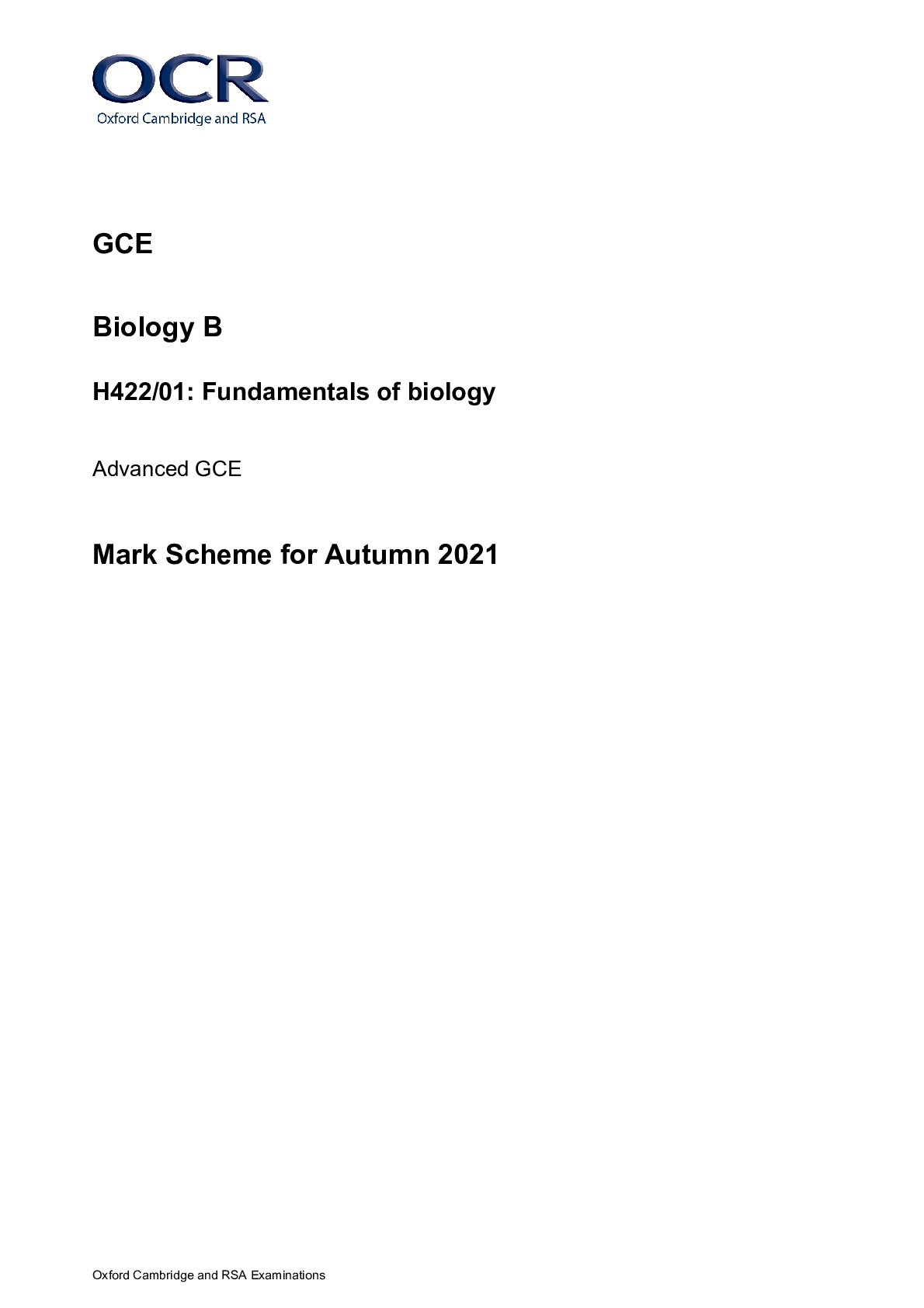
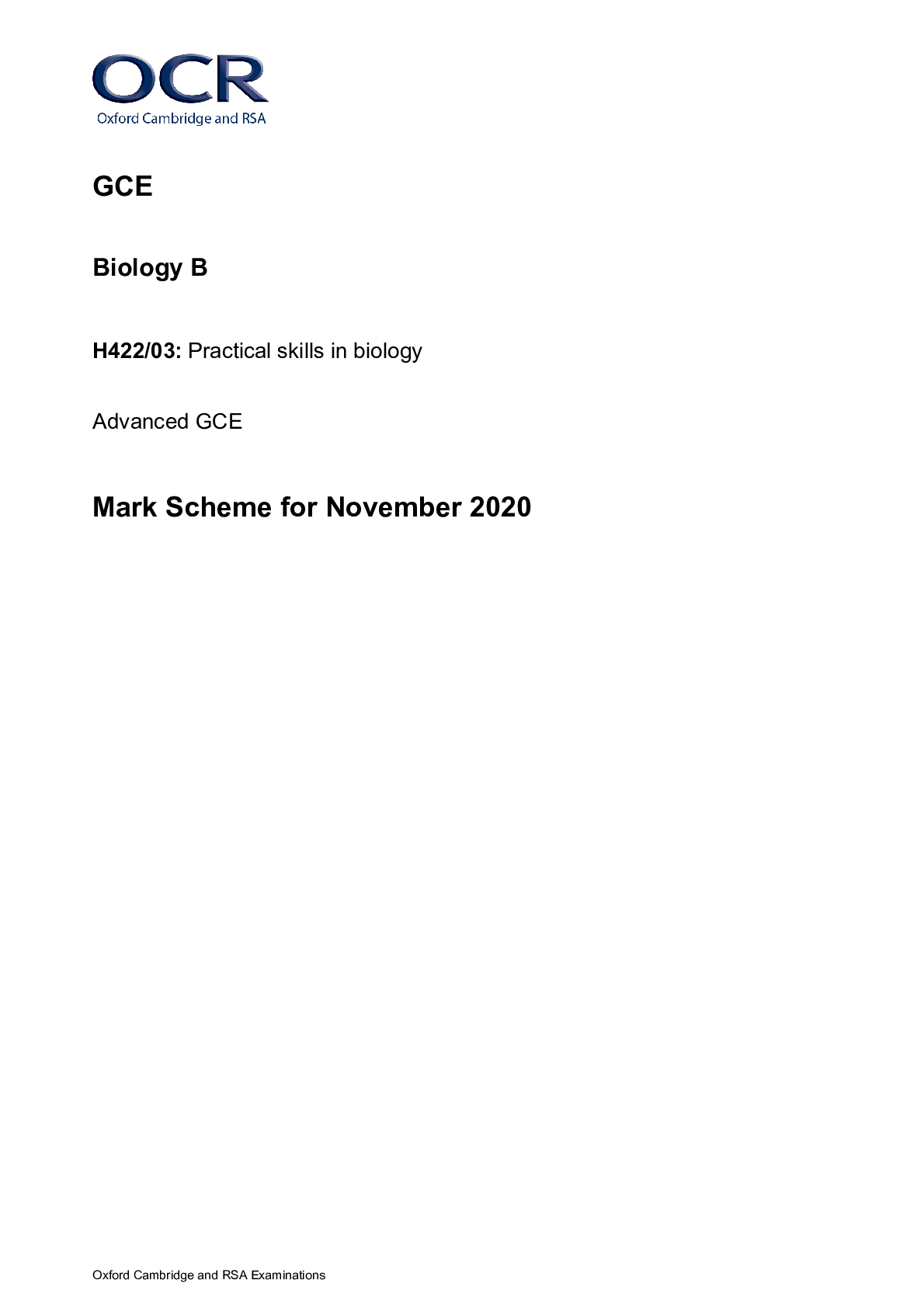
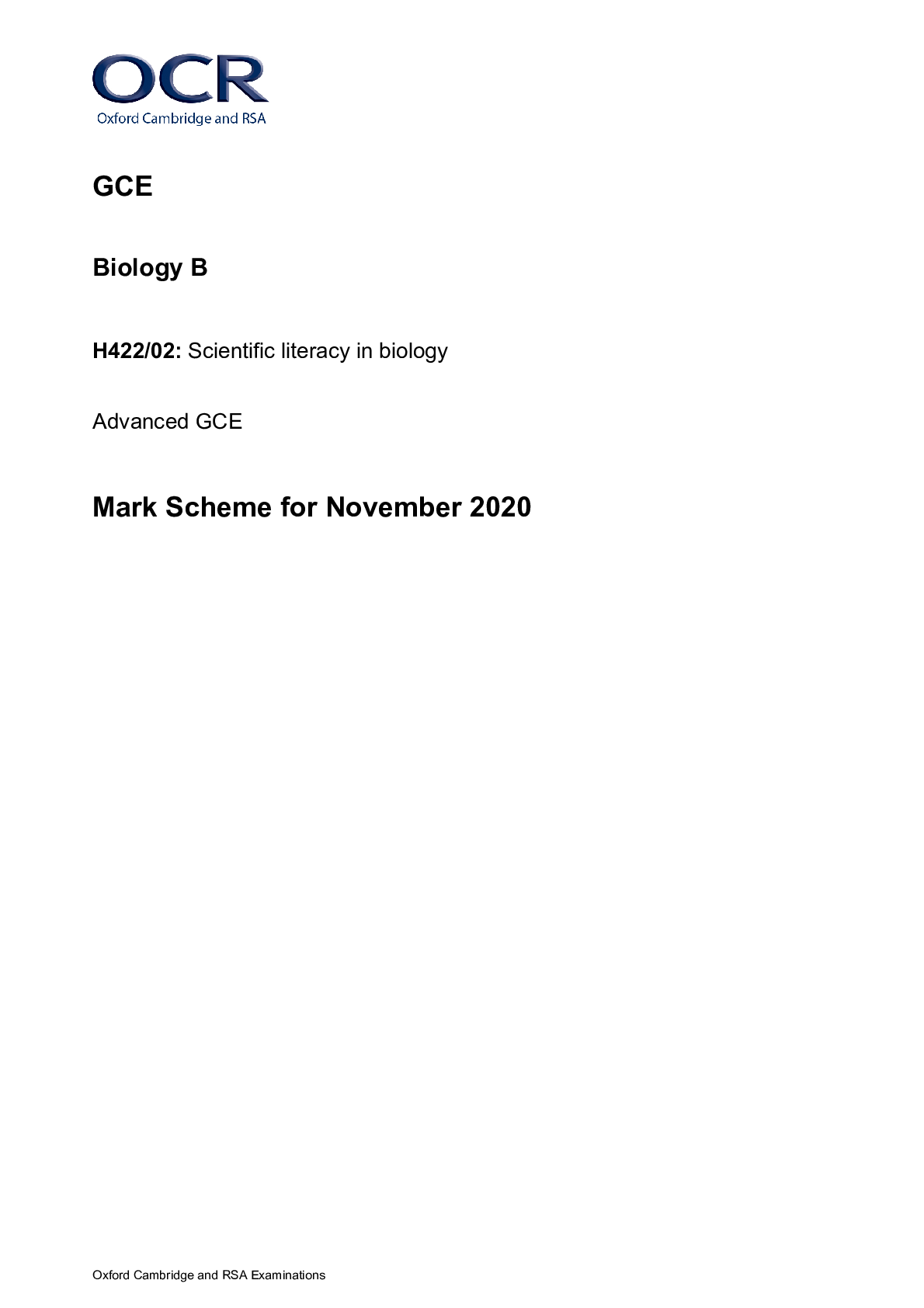
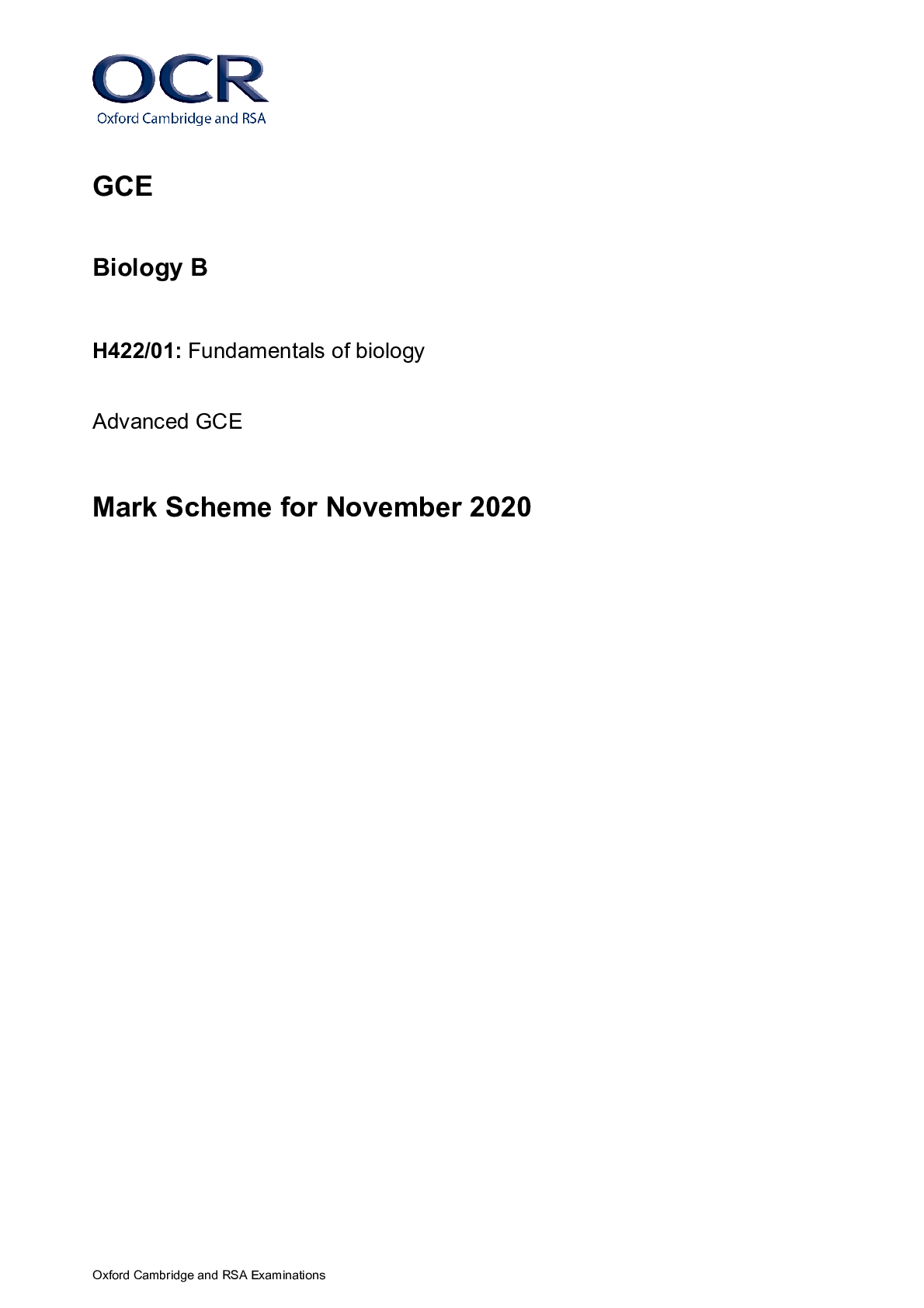

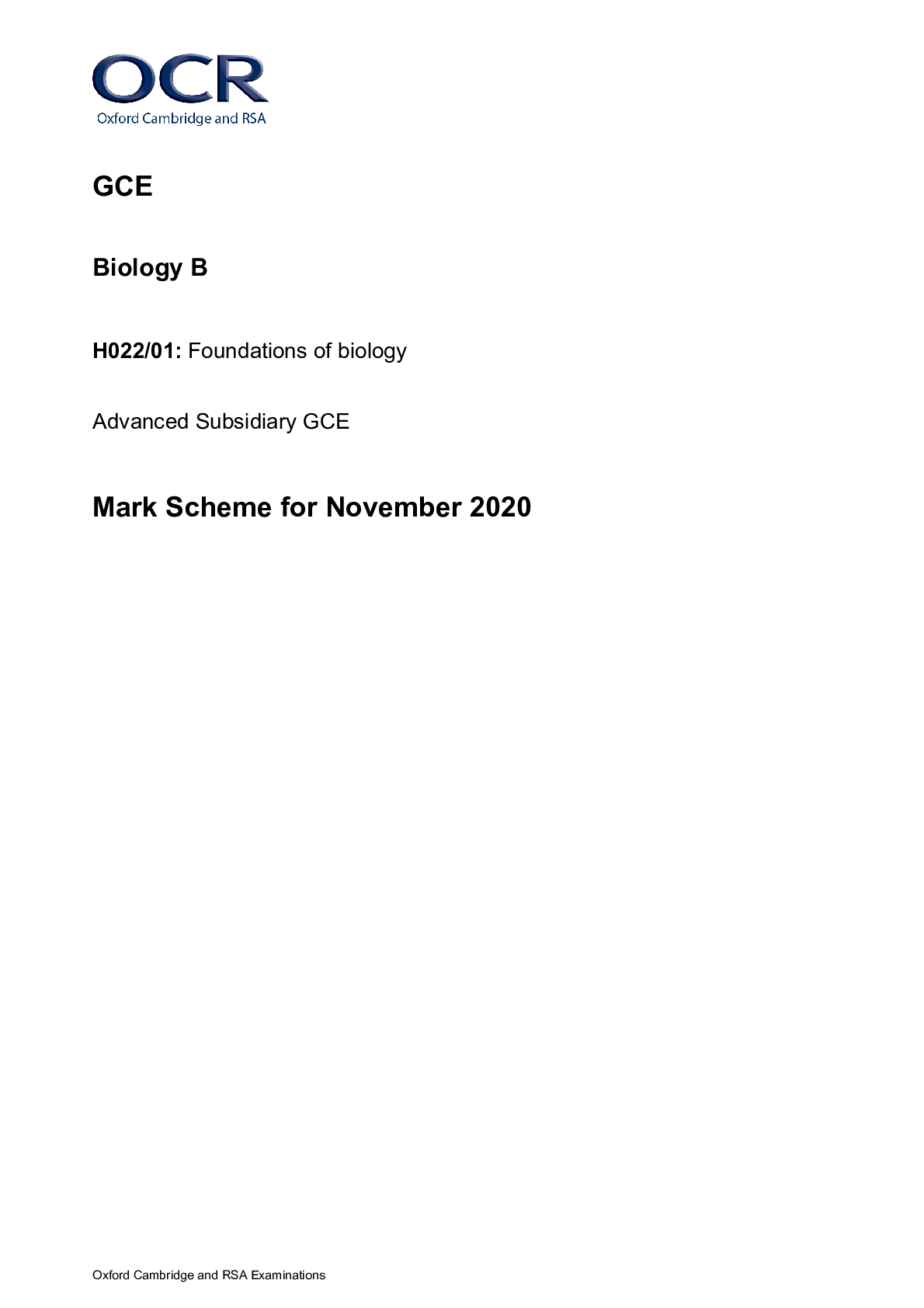
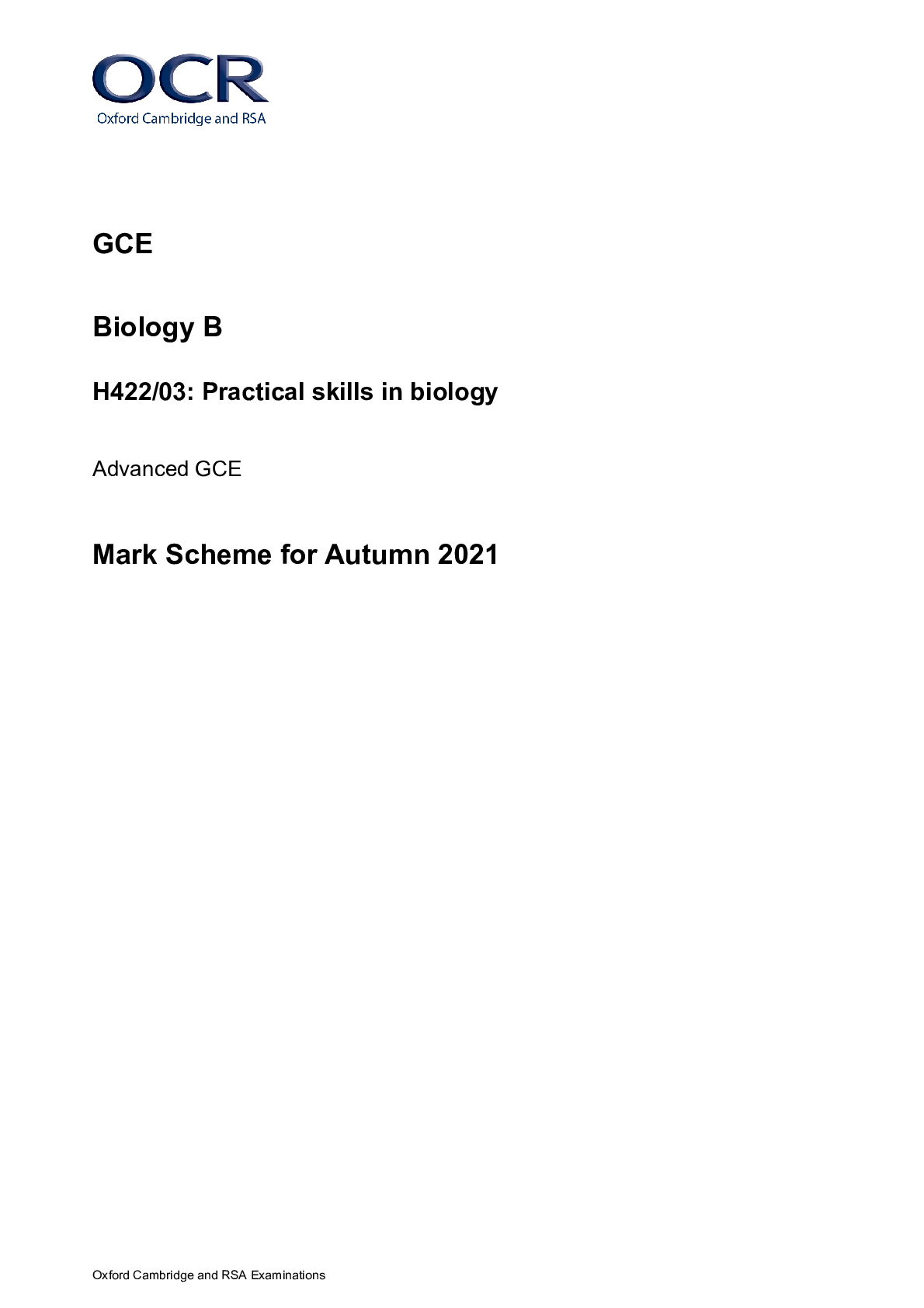
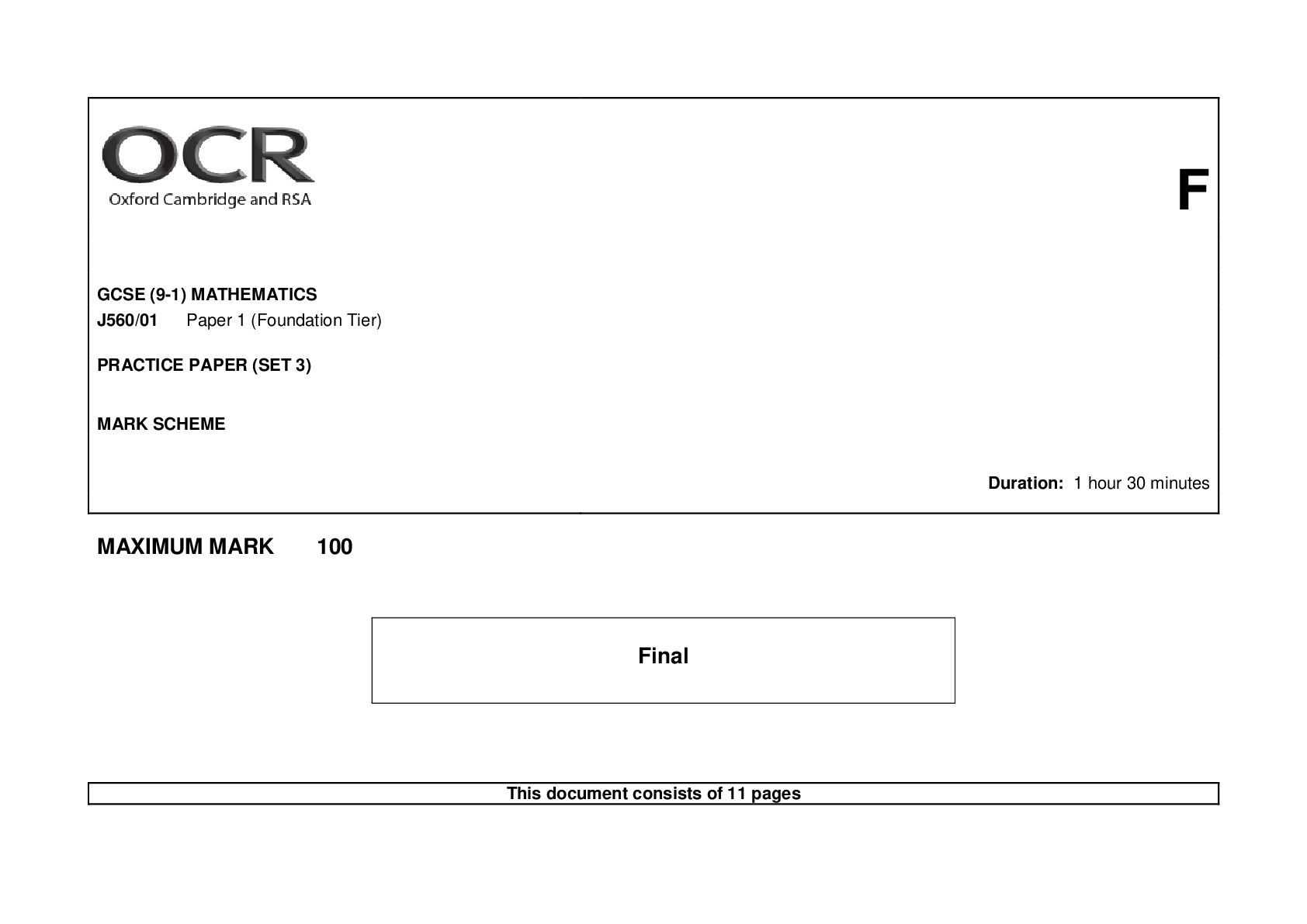
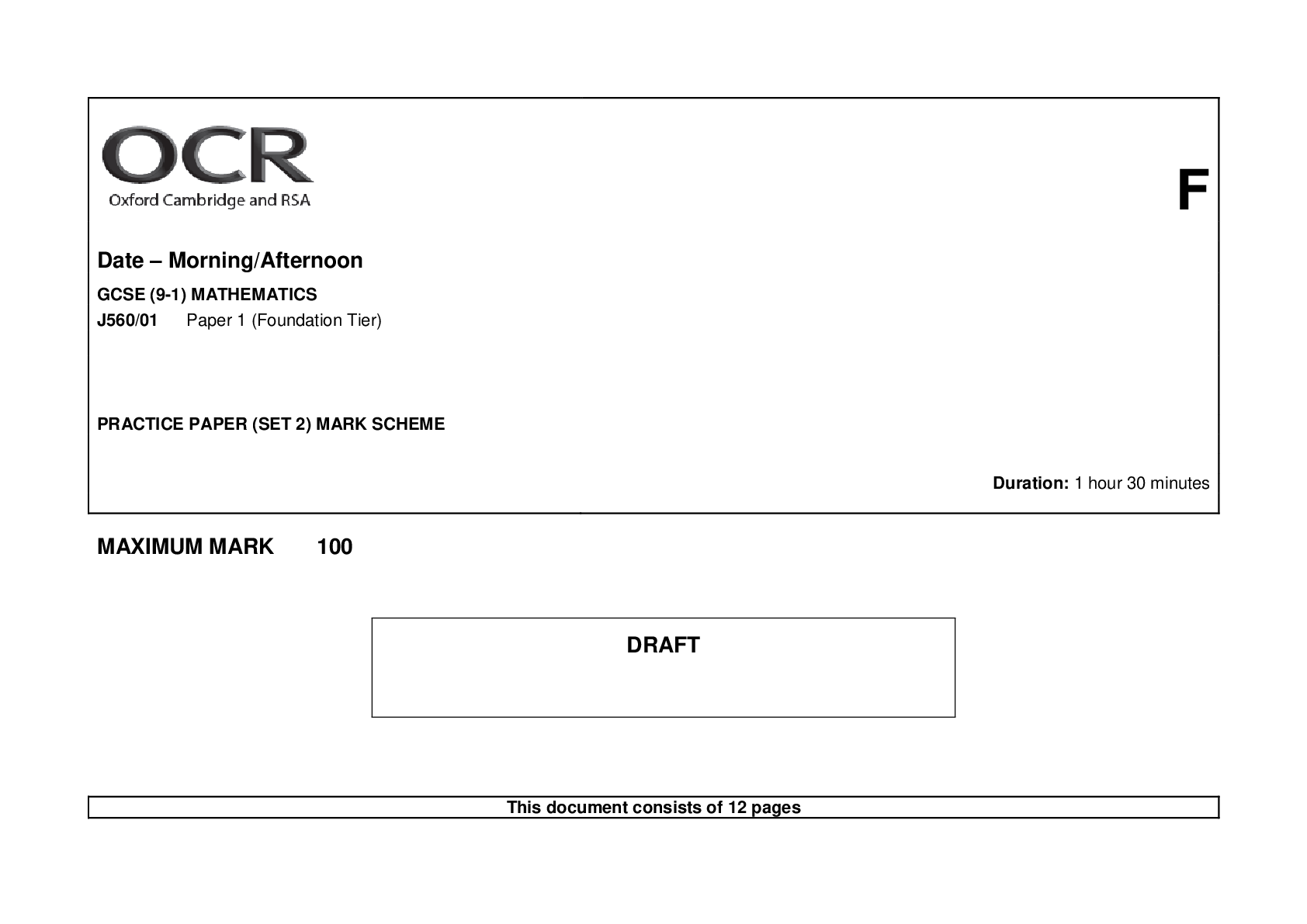
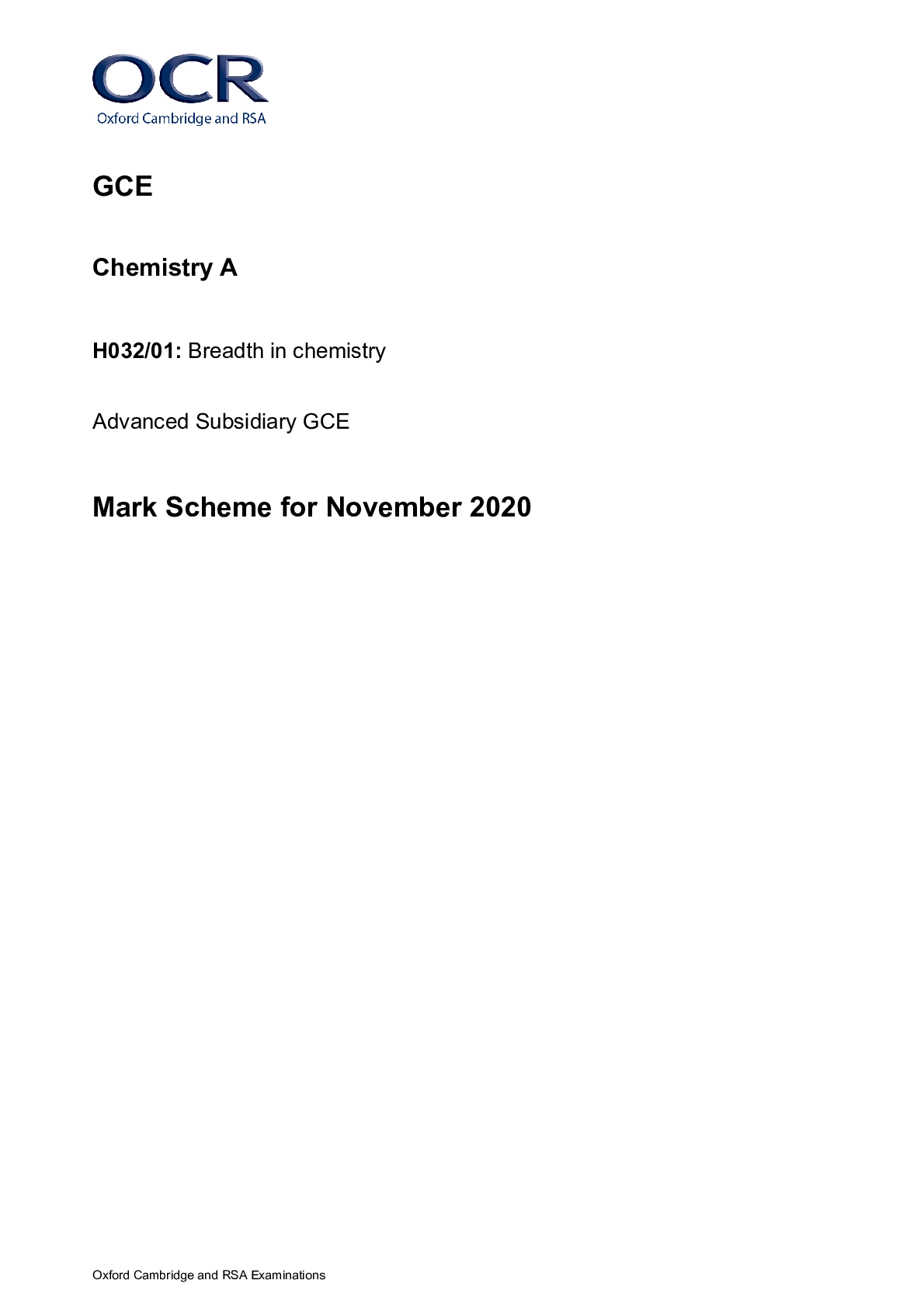

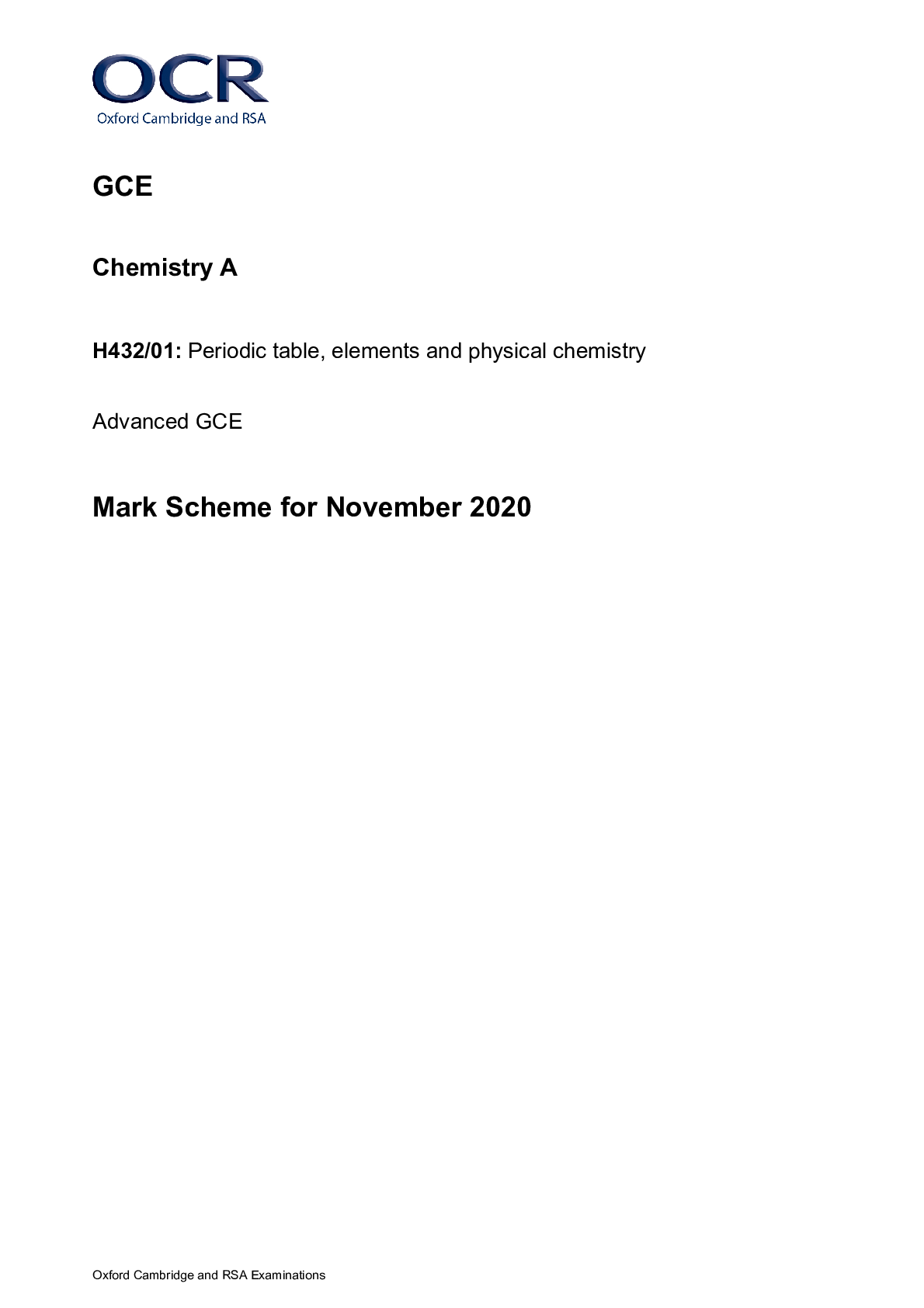
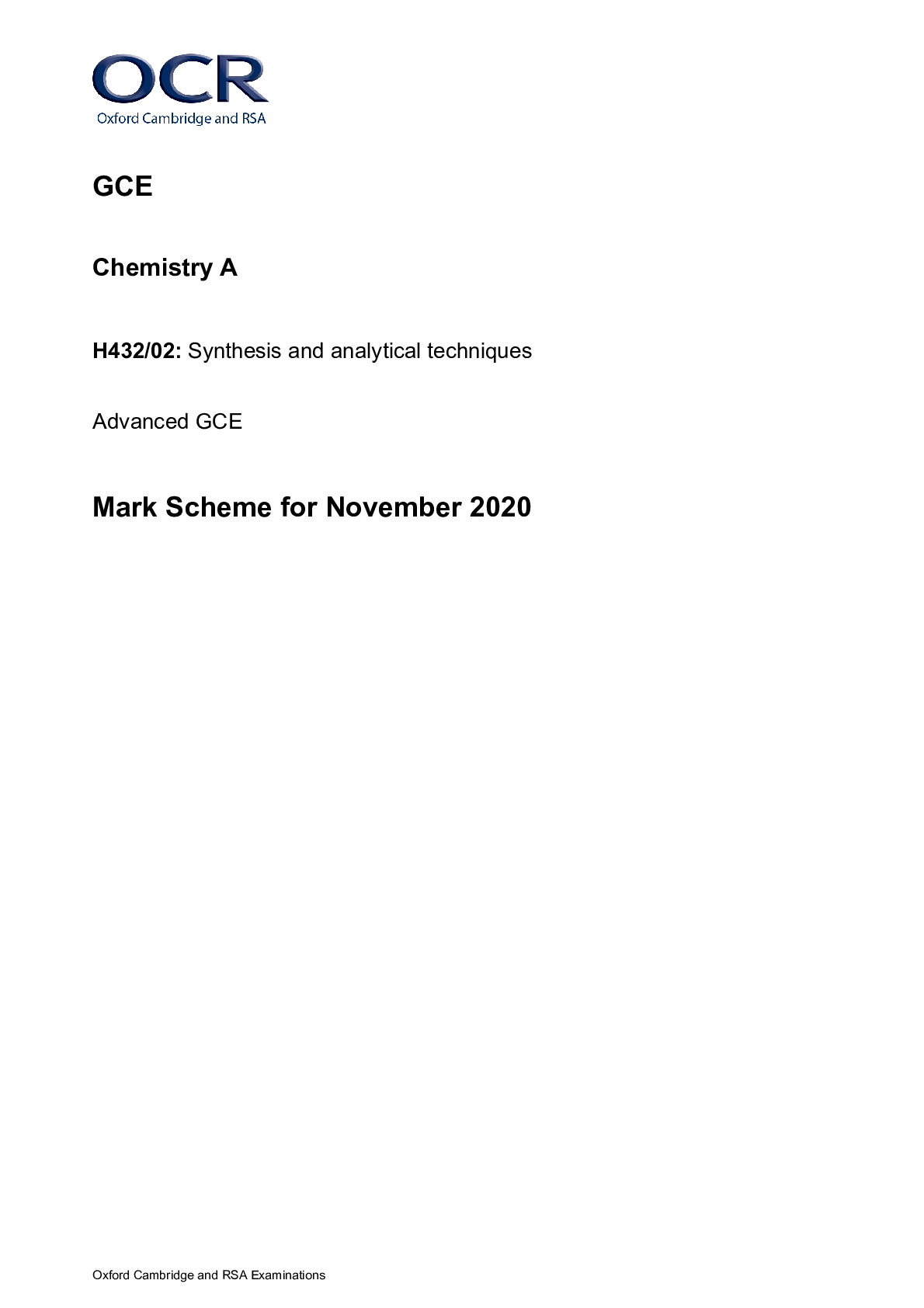

H630-02 Pure Mathematics and Statistics Advanced Subsidiary GCE Mark Scheme for Autumn 2021.png)


.png)


